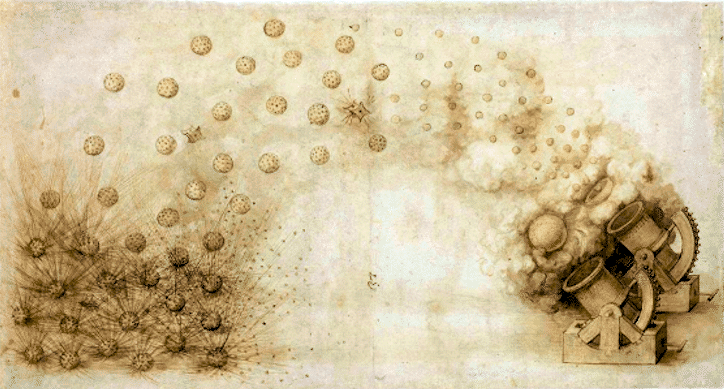The Codex Notebooks
Leonardo Da Vinci has long been considered a man of mystery. This is in spite of the fact that we have an unparalleled set of documents which illuminate his thought processes, interests and deepest beliefs. The world has access to hundreds of pages of his notes, jottings, sketches, doodles and musings, including lists of books that he read and even scraps of financial records.
Leonardo was the first to question the Biblical account of the Flood. He saw the fossils of sea creatures on the tops of mountains and concluded that these could not have been deposited in a forty day flood. Leonardo believed that mountains had previously formed sea beds, which were gradually lifted until they formed mountains. This was hundreds of years before plate tectonics became accepted scientific theory.
His concepts and theories regarding painting include linear perspective, a significant number of pages devoted to light and shading and the perspective of disappearance. His theory on colors including writings about not only perspective observation, but also how graphically areas can be portrayed in aerial perspective – a key to map making. He described botany as it relates to painting, as well as landscape art.
The natural world always fascinated Leonardo and his notebooks he includes writings on astronomy, physical geography and topographical notes as well as his studies of naval and ground warfare, mechanical developments and inventions. Less well-known are the notes his made about philosophy, morals and his humorous writings – yes, Leonardo loved a good joke.
Here is an example (translated): It was asked of a painter why, since he made such beautiful figures, his children were so ugly. The painter replied that he made his pictures by day and his children by night. Perhaps it is best that Leonardo stuck with his day job.
Leonardo is believed to have started recording his thoughts in notebooks during the 1480s. The writing in Italian, but in mirror-writing, which one reads right to left. Scholars have debated the reasoning behind this style, believing it was either a way to code his thoughts, or simply to make writing easier as a left-handed artist. It is possible to decipher Leonardo’s curious mirror-writing, once the eye has become accustomed to the style.
Many of the pages of his notebooks now appear online. For the 500th anniversary of his death, the museum has now placed online its set of five notebooks, known as the Forster Codices. It is fascinating to observe his drawings in context where on a single page will be theories about science and art, including detailed charts, as well as sketches of his favorite hat, or his horse’s front hoof.
Another set that is available online is the Codex Leicester. The manuscript currently holds the record for the second highest sale price of any book, sold to Bill Gates in 1994 for $30,802,500 (over $53 million in present dollars). The Codex does not take the form of a single linear script, but is rather a mixture of Leonardo’s observations and theories on numerous topics. It consists of 18 sheets of paper, each folded in half and written on both sides, forming the 72 page document. The movement of water that is the main topic of the Leicester Codex. Among other things, Leonardo wrote about the flow of water in rivers and how it is affected by different obstacles put in its way. From his observations he made recommendations about bridge construction and erosion.
The Codex Arundel is a bound collection of pages of notes dating primarily from 1480 to 1518. The codex contains a number of treatises on a variety of subjects, including mechanics and geometry. The manuscript contains 283 paper leaves of various size. From Leonardo’s text, it appears that he gathered the pages together, with the intention of ordering and possibly publishing them. The Codex Arundel is recognized as second in importance to the Codex Atlanticus, which is the most voluminous collection of Leonardo’s work.
The 12-volume, 1,119-page Codex Atlanticus is incredibly diverse portfolio and reveals sketches and diagrams for his creative inventions such as parachutes, war machines and hydraulic pumps, as well as detailed architectural sketches and anatomy studies. Many of these famous inventions were covered in Parts VI, VII and VII of this series, while last week’s Part IX featured the great master’s writings about anatomy. Earlier this year, an interactive website was launched, featuring each page of the codex (www.mymodernmet.com). For the first time ever, it is now possible to browse through all of the pages of this monumental manuscript.





